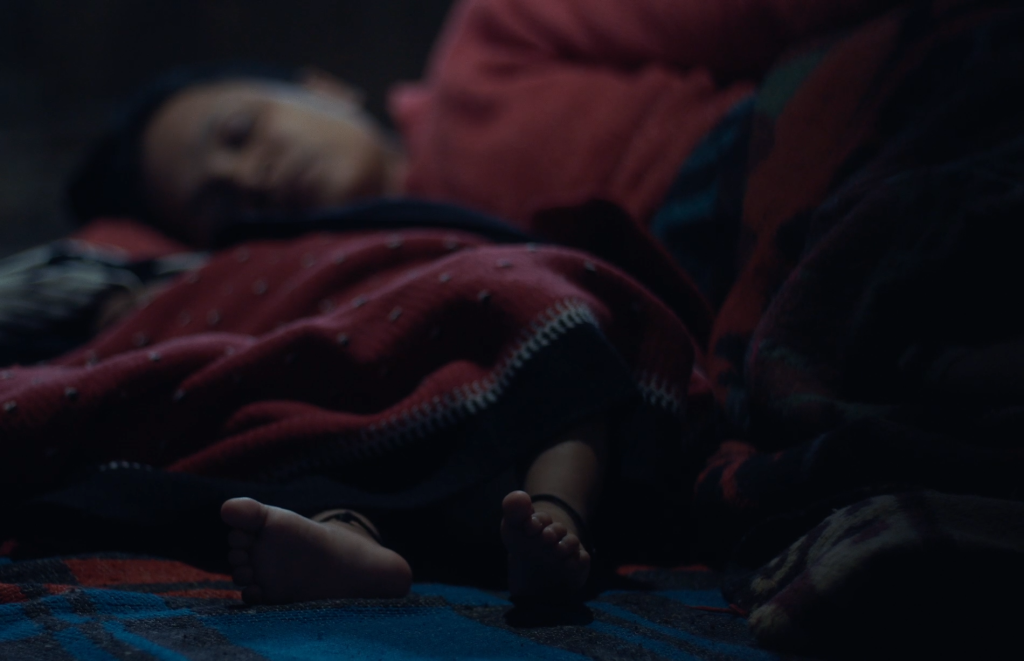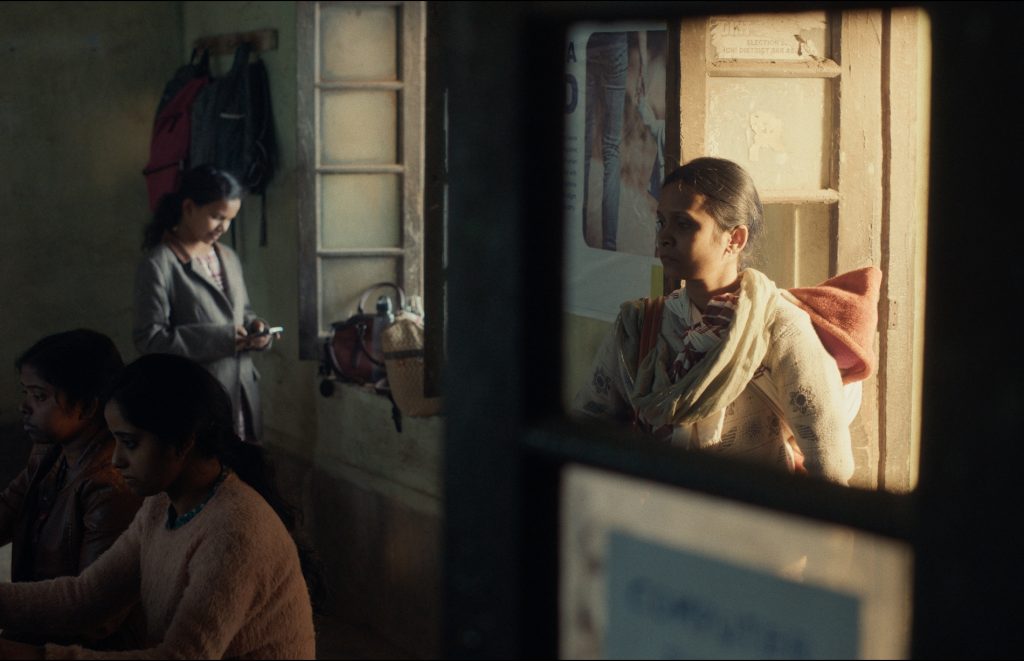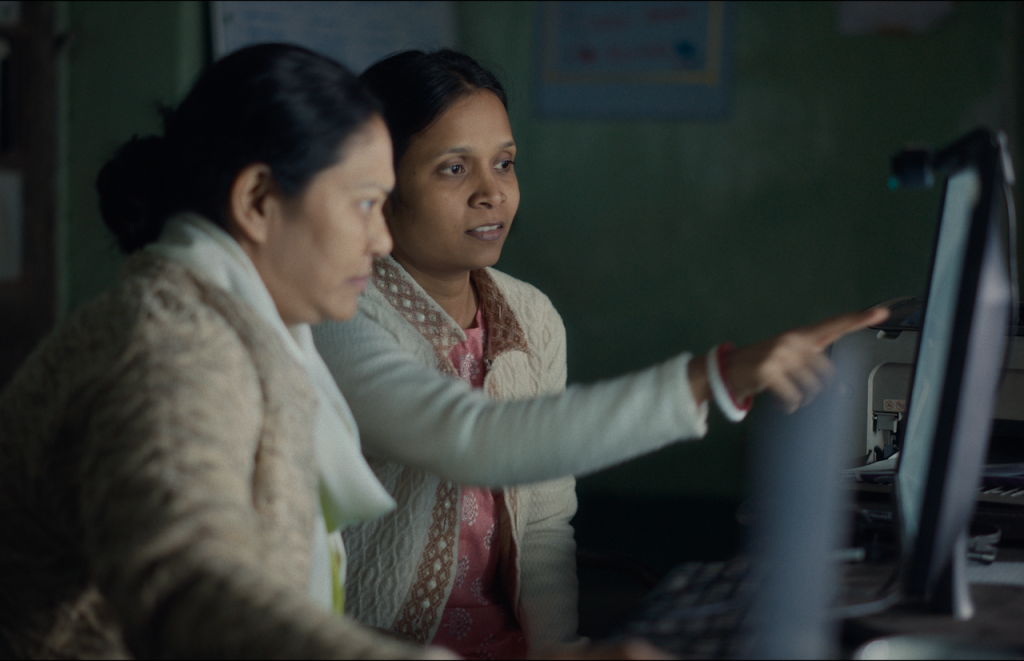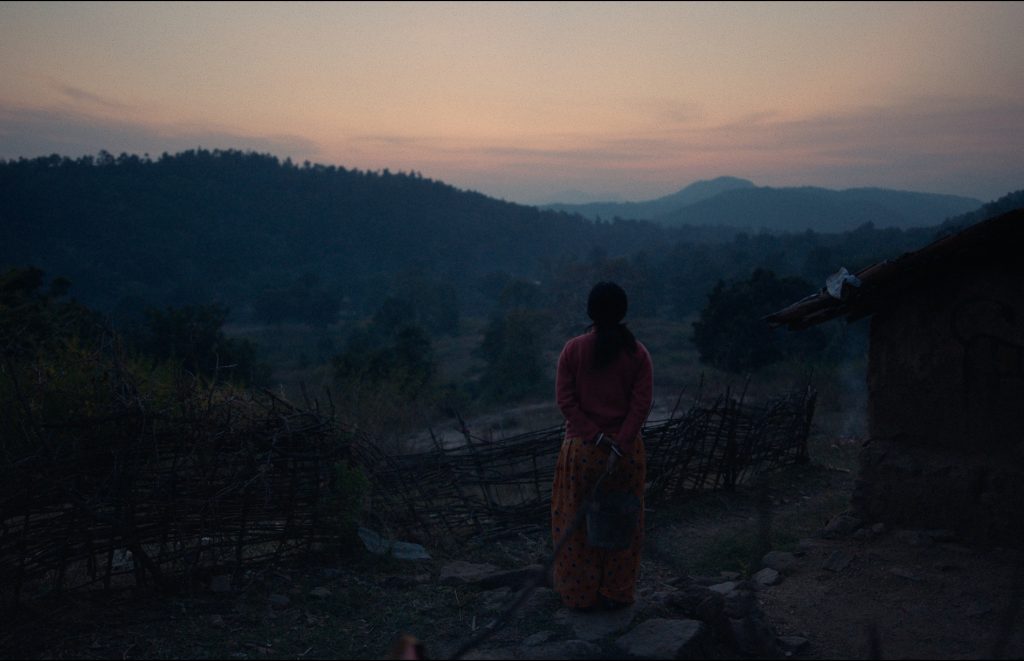Humans in the Loop (2024) is the story of an Adivasi (a collective name used for the many indigenous peoples of India) woman who begins interacting with AI while working in a data centre in remote Jharkhand. Jharkhand is a state in eastern India that has struggled against its ‘resource curse,’ accounting for about 40% of India’s mineral reserves, and with a vibrant history of indigenous people’s movements.
The film tells the story of Nehma, who, after a divorce, returns to her ancestral village with her children. To retain custody of her children and support her family, she takes up an unusual job as a ‘data labeler.’. She trains algorithms to recognize & distinguish objects, approaching the task with the care of a parent teaching their child. As she works, Nehma uncovers human biases in AI systems, questioning if AI can truly ever adapt to an indigenous worldview.
I sat down for a conversation with the director of the film, Aranya Sahay, to reflect on the unique questions the film brings up about the nature of data work, the promise of such work for women like Nehma, and what it means to tell such stories. What follows is an edited transcript from our conversation.
Susan: Let’s start at the beginning. How did the film come about? What did your research for the film look like? What are some themes that eventually emerged in the film?
Aranya: The premise comes from an article by Karishma Mehrotra called Human Touch. Apart from the fact that first-generation women workers in Jharkhand engaged in such work, there was an anecdote that stayed with me. Megha Chandran, an employee of Infolks [a content moderation firm that was started by former data worker Mujeeb Kolasseri], describes in the article how she explains her work to her family. “It’s like how, if you show a child the colour red enough times, they can recognise the category the next time they see the colour red”. The idea was that now you have this premise, I realized that I had to go into this with an understanding of data labeling. By understanding data labeling through this sort of analogy of raising a child, the film is able to look at the idea that children are what we teach them, but they might also carry a genetic memory that manifests at different stages of life. So, as one would think that AI is absolutely automated, it allows you to question if it is born from the knowledge systems of its ancestors, then whose knowledge system is it? Then the premise really came down to an Adivasi mother teaching an AI child, but she’s having to teach it on first-world data based on first-world labels and inferences that became a major conflict of the film.

This was such an exciting premise in itself, so we could have taken it towards the conversation on labor directly, but it felt like there was more here. And it really dawned on me when I was traveling through Jharkhand and you see these colonial remnants like a single gauge train or colonial arches and you had to draw the connection to what happened almost 300 years ago where there were colonizers who came to this part of the world and deemed their knowledge systems as ‘primitive’ and ‘savage’.
So the first aspect that comes in is Nehma’s own child standing up, and the AI humanoid figure learning how to stand up based on her data, which aligns her emotionally with this AI. The second one is to create conflict, which is when she’s asked to label a pest which she knows from her experience to be helpful to the crop because labelling for AI in agriculture brought out an overlap of knowledge system [used in the labelling] in conflict with this Adivasi ethos. Thirdly, there is the representation aspect, which was brought out through her engagement with AI-generated images of women from across India in stereotypical ways that were irritating.
And if AI is that child and we are the custodians of all that this planet has, what are the ideas and knowledge systems that we are passing on? Is it just this Eurocentric gaze, or can it be a bold and diverse gaze?
Like especially when the Adivasi woman begins to see AI as a living entity in this film, which happens because of a deep-seated belief that there is life in everything around her— rocks, trees, the river, trees. So her relationship to the AI is also born out of a deep-seated belief that she’s able to see life in it, and she begins to care for it. In terms of the parent-child analogy, I think there is a lot of traditional wisdom with respect to raising children, and there is an approach of tenderness when it comes to seeing this AI ‘grow up’. And if AI is that child and we are the custodians of all that this planet has, what are the ideas and knowledge systems that we are passing on? Is it just this Eurocentric gaze, or can it be a bold and diverse gaze?

Susan: One of the things from the film that stuck with me is where Nehma labels the images her daughter takes of the people in her village to train a model that can generate images that she feels actually represent her. With this moment, it becomes clear that your film centers the aspirations of some women who are engaged in this work and the possibility of them claiming their sense of ownership and agency in building the technology, in a very optimistic light. I was curious about what informed your portrayal of the Nehma in this way, and how this optimistic tone comes about.
Aranya: The film largely goes on the positive side of this question because in my conversations with some women data workers, I realized that they prefer working in a data center then working in the field because agricultural labor can be deeply exploitative. Here is a steady monthly income; a monthly income, however undervalued, is steady income. It’s seen as a very dignified space because otherwise, these economies are driven by seasonal employment. Especially because it’s got to do with technology. There is a certain sense that people working in technology are doing something great, and then there is an aspect of it being a company from abroad.
Mary L Gray has spoken about “ghost work,” which is absolutely hidden in the whole AI pipeline, where we think that it is just an algorithm, but there are these human beings who are just constantly doing this tedious work to make it work.
Mary L Gray has spoken about “ghost work,” which is absolutely hidden in the whole AI pipeline, where we think that it is just an algorithm, but there are these human beings who are just constantly doing this tedious work to make it work. The first thing that comes to mind with this [kind of work] is the exploitation of cheap labor. But as for the data labelers speaking about this, I think that conversation is going to come maybe a few years from now. For now, they feel happy to be working in this sort of space because they see it as more dignified than the alternatives available to them.
These women data labelers, for the most part, don’t know the kind of impact that their work is going to have on the larger AI ecosystem, so they just do their part and leave. However, there was this one data labeler who was speaking about certain seeds they were labeling as part of this agricultural labeling program, and she was told that this particular seed needed to be sown in this season. She countered her manager on this, saying that if you sow it in this season, it’s going to destroy the longevity of that field, so we sow it in another season. The manager took that insight, but this is just a one-off instance that I’ve observed. I do feel that there is going to be a larger labor conversation that will come from within, and that there is going to be some unionization that happens from within, but right now it’s not entirely there.

So, I think I have to establish that the proxy software on which they are testing the data that has been labeled in the film doesn’t exist in data labeling centers. There is no processing software; they just have to do the work of tagging and then they go. They don’t see the impact. Now, that is fictionalized, but that is a significant difference from reality. We fictionalized it entirely because the agency comes from being able to see the impact of the work. When they begin to understand that ‘my work is leading to this,’ then there are questions of ‘where is my identity in this?’
There is a sense of underconfidence in the community, but when somebody misrepresents something or talks about something incorrectly, there is a certain anger and a burst of revolt.
We also have to understand that this [film] comes from the CSR (Corporate Social Responsibility) space, right? While they didn’t dictate how to and where to go with the story at any stage, there was a certain self-attunement towards telling this story through this parent-child analogy and not the content moderation story or the AI in policing story. But because I had to navigate that, I can show that a worm is being burned violently. But that is an associative image. I can’t show what AI potentially could do to human beings, but you can perhaps talk about it in that associative way.
So the choice of which module we’ve explored in the film is the three or four [applications] that I think could lead to sort of involvement. Everybody is talking about how we can automate systems in agriculture, I think that has a lot of scope for indigenous people’s involvement. The other is the representation aspect. There is a sense of underconfidence in the community, but when somebody misrepresents something or talks about something incorrectly, there is a certain anger and a burst of revolt. So I think that the last scene where she’s represented incorrectly comes from…that sort of feeling of revolt from within.
Susan: That’s an interesting observation because I also think what’s so powerful about the film is that it lets you imagine this alternative where Nehma is very conscious of the work that she’s doing and what it might translate into. As you say, at the moment, it’s a dry job where they do their job, they go home and have these partial views into what they’re creating, but not always. They don’t have an embodied sense of the impact of the work that they create. They don’t often experience the technologies that they’re helping build.
While there’s increasing awareness of the existence of ‘humans in the loop,’ their marginalized social positions—and the resulting dissonance between their lives and Silicon Valley’s grand narratives of technological development—often remain invisible. What are the stakes in telling the story of AI from the margins? Why do their lives, communities, traditional knowledge systems, aspirations, and family lives matter to the story of the ‘AI revolution’ we find ourselves in? What are the stakes of making these narratives more visible, what kind of value might they hold in our broader imagination of a technology like this?
Aranya: If you look at it as sci-fi, it looks at AI as a very distant entity, not in the sense of the future, but…that it is away from human morality, so to say. You look at it look at a film like Terminator, or more recently, The Creator, or even Her, there is a sense of dissociation between human morality and AI. I believe, at least in this film, we are dealing with AI in how it is happening today and what is happening with it today, to talk about a stage of AI evolution which is which is pre-Artificial General Intelligence (AGI), at this place and this time where we are in the development of AI. So we deal with questions of identity in the way of representation in AI art or AI in agriculture.
I believe, at least in this film, we are dealing with AI in how it is happening today and what is happening with it today, to talk about a stage of AI evolution which is which is pre-Artificial General Intelligence (AGI), at this place and this time where we are in the development of AI.
Susan: I think what’s interesting about the film is also that it’s able to do this from a position that’s very embedded, located in a very specific context. What were the things that you thought were essential to situate your protagonist outside of the data center? Seeing how she interacts with her village, with the forest, with the land, her interpersonal relationships, and her family. So I’m wondering if you could shed light on the thought process in terms of what else you wanted to bring into this that isn’t directly about the relationship of the data worker to the actual work of data labeling. Why is it important to talk about all these other things that situate them in all of these other social contexts?
Aranya: The film has this aspect of a Dhuku marriage where she enters this live-in setup, which is looked down upon, even in a rather progressive Adivasi society, because of which this social boycott happens to her. I think different women, even Adivasi women, come from different and varying experiences. Some Adivasi regions are near the city of Ranchi, some are near Jamshampur (an industrial town), and some are in extremely rural pockets. At the cusp of some kind of modernity, there would be different kinds of women, some who would have had a Christian education, or some English education, or computer education. And then some women have been workers in garment factories or agriculturalists all their lives before they get into this work, because this work didn’t exist before. Women come from different backgrounds that inform their work. In the film, [Nehma] is able to identify that a root is not ginger but turmeric based on how the nodes grow from her experience foraging as it is part of the Adivasi knowledge of the forest.
But in reality, I think there is a lot of distance because at the end of the day, you have a target to label 500 photos and videos. So I don’t know how much agency can come into the work. I think there is a dissociation in what they’re able to bring from their lives or even where they come from philosophically, and their livelihood.
Susan: You’ve been touring with the film, and you’ve been interacting with various audiences across India. What kind of perceptions have you kind of noticed in your interactions with the audiences? How have these depictions resonated? Is there still some novelty and shock about these grand technologies really just being built off the labor of people coming from incredibly marginalized positions in the Global South? Are there criticisms?
Aranya: The reaction is mostly, “There is so much noise and fear around AI. We didn’t imagine a positive side to how things might unfold.” Post the screening, the conversation goes towards the optimistic for sure. The current stage of gen AI can lead to more humane automated processes, representations, or it can go down the downward slope of being very narrow. Most people who watch the film have questions about the porcupine as a symbol in the film. ‘Why this optimistic route?’ is a big question.

One criticism I’d like to share, which is very interesting, is that somebody asked if I think AI and Adivasi worlds are congruent. In terms of the fact that these technologies haven’t reached those areas as much as we’d like to think. But also because of the chips and the minerals, the silicon or cobalt, on which AI development is built, are being extracted from indigenous lands in Africa and other parts of the world. And that is a valid and absolutely fundamental question and criticism. But I believe that there’s another film for that.
There is a certain ‘wow’ factor for sure that there are Adivasi women doing these AI jobs in an ‘Oh, I did not know about that’ way.
There is a certain ‘wow’ factor for sure that there are Adivasi women doing these AI jobs in an ‘Oh, I did not know about that’ way. But there is a certain cynicism with respect to AI itself, so there is a lot of conversation navigating the fact that the film does not pander to that cynicism in a simple way.
Susan: Offering an optimistic imagination of technology despite a tendency for technophobia or cynicism is also interesting. Considering that there is a tremendous investment in building the hype around AI and very real financial motivations to sustain that hype, it does seem like we need to put in a lot of work to positively imagine just AI futures beyond whatever AI hype the industry pushes or some disengaged cynicism. But the question of artificial intelligence has been very interesting to us in fiction. I’m wondering if you think there is actually a meaningful space within our culture to think about what these technologies mean for us socially, in a real sense.
Aranya: I think the space comes from the fact that there are users and then there are creators in the AI space. And I think among users there’s hyped up pessimism, and in the creator space there’s a hype of optimism. I think that can be bridged by transparency on where we are with the development of certain things. How are we sourcing the material to train AI on? How are they able to make AI-generated Studio Ghibli images without paying Ghibli anything?
So, one conversation we wanted to start with this film was simply to bring attention to the fact that there is this ghost work happening in the remote parts of India, and all while we speak about AI being this massive revolution happening on its own. I think the biggest thing is that we have to put little cultures in larger cultures. There needs to be an imprint of the little culture as much as there is of the larger. That’s a conversation that I wanted to have with the film is that we missed that bus on the choice that ‘I will not be a part of this AI moment.’ It’s going to affect our lives one way or another. And so it’s better to engage with it than to let it…be distant from you.
Humans in the Loop is one of two projects incubated at the Storiculture Impact Fellowship 2023, dedicated to bringing narratives of India’s digital societies to a wider audience through film. Alongside “Taak,” these projects form the first initiatives of the Museum of Imagined Futures (MOIF), a platform that leverages creative media to explore and mainstream critical topics at the intersection of technology, society, and culture. For more information about MOIF, please visit museumofimaginedfutures.com
Humans in the Loop | 74’ | India | 2024 | Hindi, Kurukh
Written and Directed by Aranya Sahay
Producers: Mathivanan Rajendran, Sarabhi Ravichandran, Shilpa Kumar
For queries or collaborations, please contact sarabhiravichadnran@thestoriculturecompany.com.